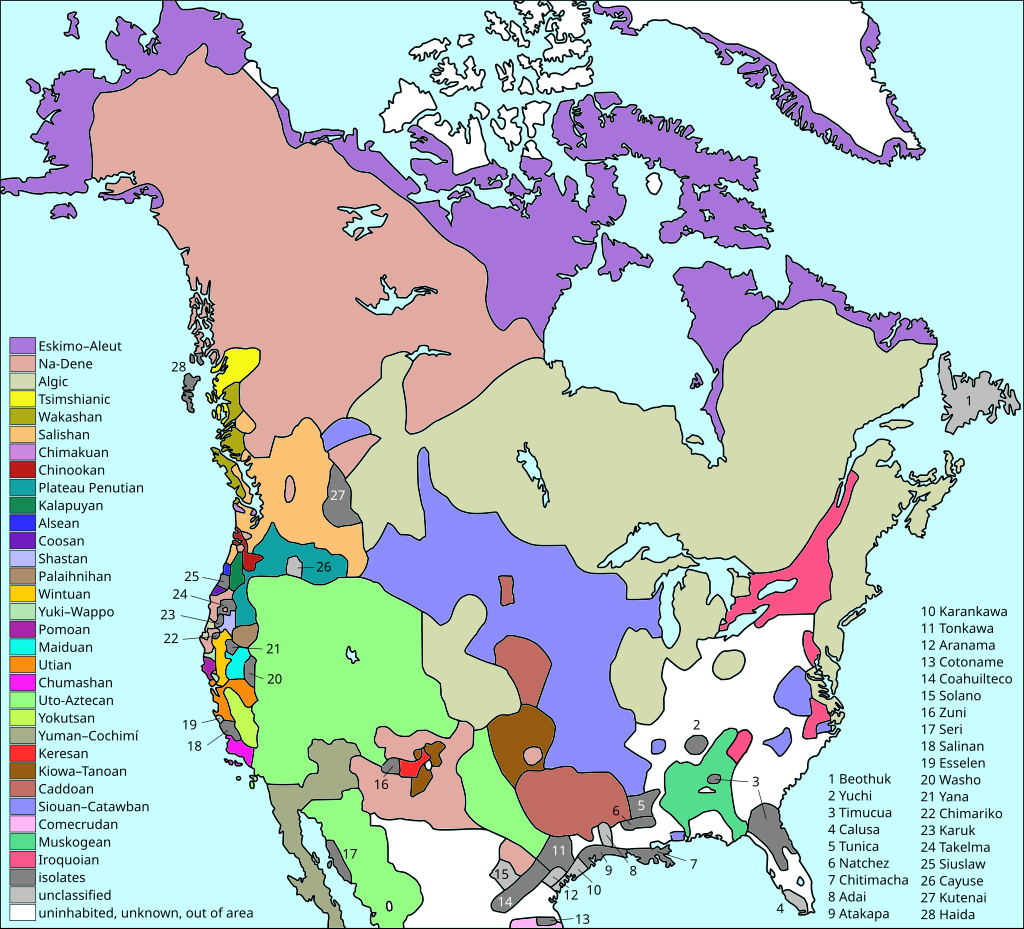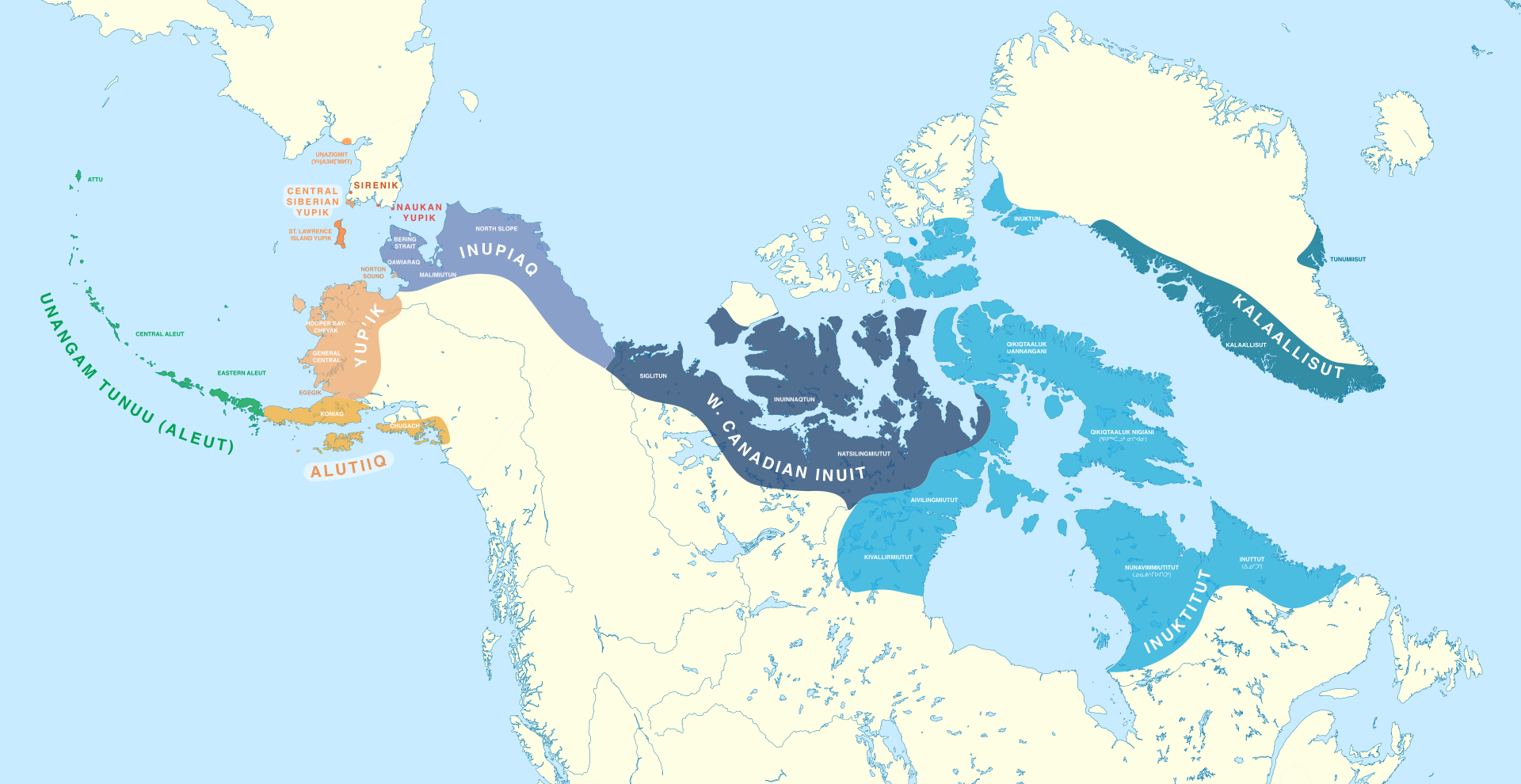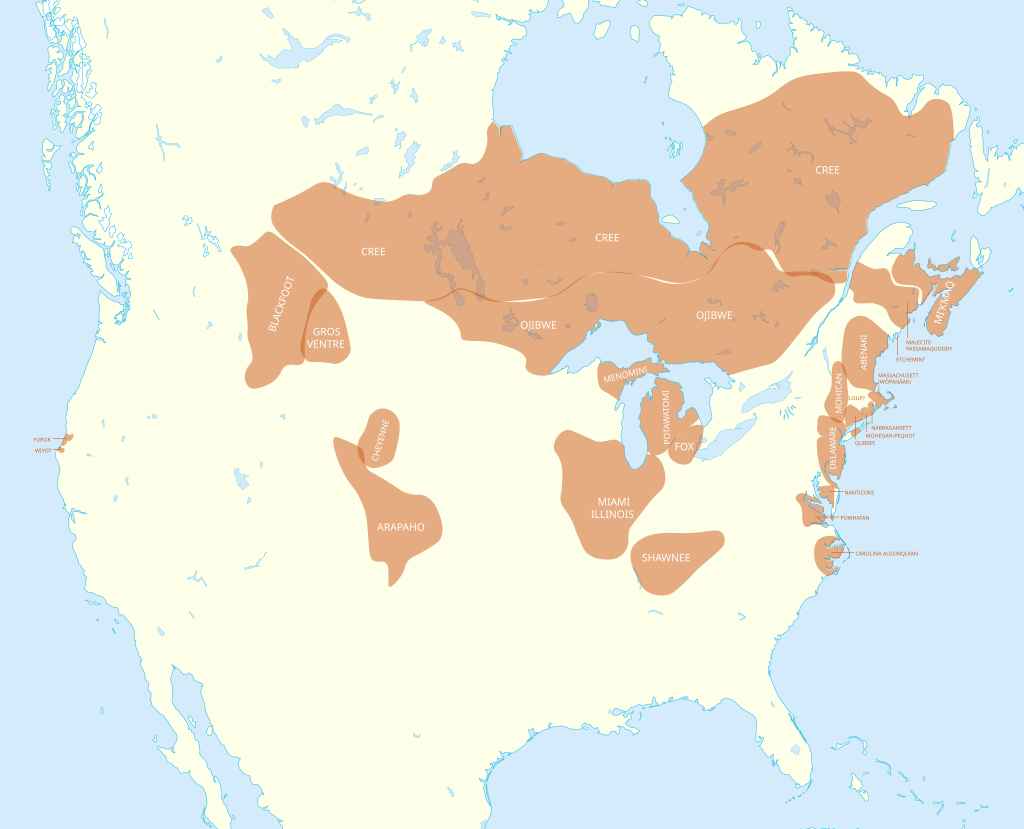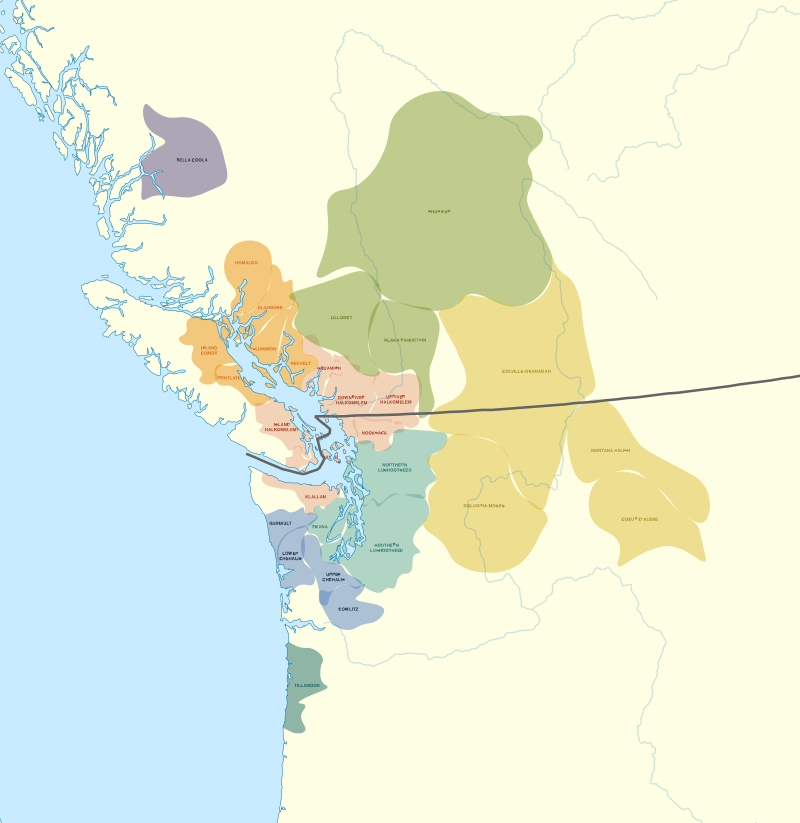[This is a talk Jack Martin prepared for Randi Moore’s course Language Patterns, April 2020. The idea is to listen to the audio recording while scrolling through the text below. If you’d prefer to read, there’s also a script below.]
Script (pdf)
Key points:
- The Americas were settled at least 15,000 years ago.
- In North America, there are 296 languages in 58 groups (30 families and 28 isolates). Half are spoken today.
- Europe was settled 40-50,000 years ago, but there are just five groups (four families and one isolate).
Indigenous Languages of North America (source):

Eskimo-Aleut languages (source): The two largest languages are Greenlandic (54,000 speakers) and Yup’ik.

Na-Dene languages (source): The greatest diversity within the family is in Alaska and Canada. Navajo and Apache belong to this family.

Algic languages (source): The Algonquian languages belong to this family. Cree, Ojibwe, and Blackfoot are members. Pocahontas spoke Virginia Algonquian.

Iroquoian languages (source): Cherokee and Mohawk are Iroquoian languages. Nottoway was spoken in southern Virginia and documented by a professor at W&M.

Siouan-Catawban languages (source): Tutelo-Saponi was a Siouan language spoken in western Virginia. Others include Lakota and Osage.

Uto-Aztecan languages (source): Ute (in the north) and Aztec or Nahuatl (in the south) give this family its name.

Salishan languages (source): Lushootseed and Halkomelem are two Salishan languages.

Muskogean languages (source): Choctaw and Muskogee (Creek) are Muskogean languages.

Some Typological Features of NA Languages (from the World Atlas of Linguistic Structures)
Ratio of Consonants to Vowels (source): Red=high; pink=moderately high; white=average; light blue=moderately low; blue=low. Key point: the ratio of consonants to vowels varies in North America. The Pacific Northwest (Salishan and neighboring languages) have lots of consonants!
Order of Subject, Object, and Verb (source): Grey=no dominant order; blue circle=SOV; red circle=SVO; yellow circle=VSO; yellow diamond=VOS. Key point: word order varies in North America. The Pacific Northwest has verb-initial languages. The southeast has SOV order. The northeast has indeterminate order.
Inflectional Synthesis of the Verb (source): Dark red=12-13 categories per word; red=10-11; orannge=8-9; light orange=6-7; white=4-5; light blue=2-3; blue=0-1. Key point: verbs in North American languages are generally highly inflected.
Locus of Marking in the Clause (source): Red=head marking; blue=dependent marking; purple=double marking; white=no marking; yellow=other. Key point: most languages in North America are head marking.
Take-aways: The languages of North America vary in the number of consonants relative to vowels and in word order, but they tend to have rich verbal morphology (often agreeing with arguments of the verb).
Further reading: There are lots of sources online about efforts to revitalize or reclaim indigenous languages:
- Wikipedia entry for Language Revitalization
- watch a documentary: First Language: The Race to Save Cherokee
Exercises
1. Looking at the first map (on the language groups in North America).
- What factors do you think might lead to language diversity or uniformity in an area?
- Can you tell what time period the map represents?
- What are the three language families indigenous to Virginia?
- Do you think everyone agrees on how many languages and families there are? What factors might lead to different numbers?
2. English-speaking settlers borrowed words from Algonquian languages in Virginia. Look on the web to see which common words in English you can find from Virginia Algonquian or Powhatan.
3. Read Nichols and Bickel briefly and then consider the following examples to determine whether they would classify Muskogee as head marking, dependent marking, double marking, no marking, or other. (The first line is phonemic, second line is glosses, third is English.)
a. pó:si-n hî:c-ey-s
cat-OBJECT see-FIRST.PERSON.SINGULAR.AGENT-INDICATIVE
‘I see the cat’
b. pó:si-t ca-hî:c-is
cat-SUBJECT FIRST.PERSON.SINGULAR.PATIENT-see-INDICATIVE
‘the cat sees me’
c. ifá-t pó:si-n á:ssi:c-ís
dog-SUBJECT cat-OBJECT chase-INDICATIVE
‘the dog is chasing the cat’
4. Many North American languages are described as having a high degree of synthesis. The following interlinear text is part of a story in Muskogee (Creek) (source). Your task is to calculate the average ratio of morphemes per word in Muskogee and in English in this sample. (The first line is the Muskogee community spelling. Second line is phonemic, divided into morphemes. Third line is the glosses. Fourth is English.) What ratio did you get for Muskogee? How about English? How do Bickel and Nichols calculate a ratio for synthesis?
The hunter and his dogs
Heyvt fakvn ayesasvtēt omet os cē.
hiyá-t fá:-ka-n a:y-i-sâ:s-ati:-t ô:m-it ó:-s cî:
this-T hunt-GER-N go.SG.Lgr-I-be.some.Fgr-P5-T be.Fgr-T be.Lgr-IND DCL
This is about someone who went hunting.
Este hvmket enokkēt wakkvtēs.
ísti hámk-it inókk-i:-t wâ:kk-ati:-s
person one-T sick-DUR-T lie.SG.Fgr-P5-IND
A man lay sick.
Momet ehiwv ocēt omvtēs.
mo:m-ít ihéywa ó:c-i:-t ô:m-ati:-s
be.so.Lgr-T 3P.wife exist-DUR-T be.Fgr-P5-IND
And he had a wife.
Momet hvtvm efvn su̜lkēn ocēt omvtēs.
mo:m-ít hatâm ifá-n sŏlⁿk-i:-n ó:c-i:-t ô:m-ati:-s
be.so.Lgr-T again dog-N many.Ngr-DUR-N exist-DUR-T be.Fgr-P5-IND
And he also had many dogs.
Momen mv este-honvnwv tat, ehiwvt mv este-honvnwv enokkan ennaoret arvtēs.
mo:m-ín ma isti-honánwa-ta:t ihéywa-t ma isti-honánwa inókk-a:n in-na:ô:ł-it a:ł-atí:-s
be.so.Lgr-N that person-male-ATN 3P.wife-T that person-male sick-REF.N D-bothered-T go.about.SG.Lgr-P5-IND
Now the man’s wife was tired of the sick man.
Momet mv efvo ‘somv̜lkvn enhomecētut ont,
mo:m-ít ma ifa-ó s-omălⁿka-n in-homíc-i:-t-o-t ón-t
be.so.Lgr-T that dog-also INST-all.Ngr-N D-angry-DUR-T-FOC-T be.Lgr-T
She was annoyed with all the dogs, too,
efv tat nvfketekayet mv hoktēt ‘sarvtēs.
ifá-ta:t nafkitíka:y-ít ma hoktí:-t s-a:ł-atí:-s
dog-ATN beat.Lgr-T that woman-T INST-go.about.SG.Lgr-P5-IND
and would go around beating them.



